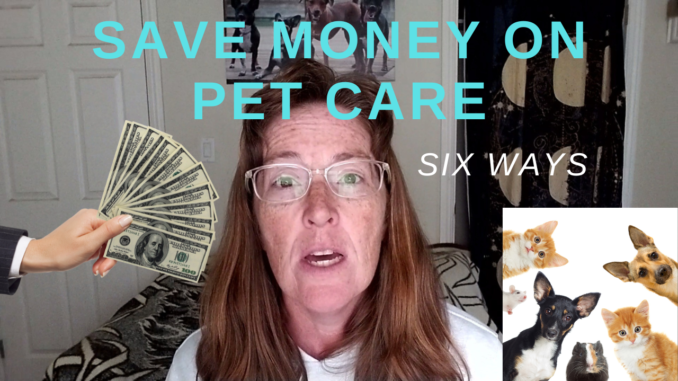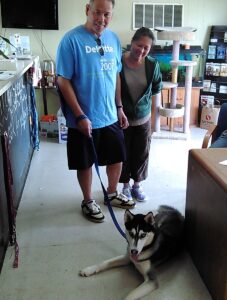
Frugal living is not just a trend, it’s a smart way of life. Most people have no idea where their money goes; they live paycheck to paycheck, never getting ahead or saving for an emergency. When they need money, they are forced to borrow from a friend or family member, max out a credit card, or take out a loan, continuing the downward spiral into debt. Caring for pets can make those monthly expenses – and the chance for needing emergency funds – much higher, but it doesn’t have to be this way. If you’re already a frugalista or if you’re just starting to make positive changes to your financial situation, here are some tips that will be helpful to you in saving money on pet care without compromising quality.
This article deals specifically with pets. If you’re new to frugal living there are many great blogs and YouTube channels that will give you great general advice. Just do a search for “frugal living,” or “saving money.”
Veterinary care
The biggest expense for most pet owners is vet bills. You can easily spend $200-$300 on a routine visit, and $1,000 or more on an emergency. How can this be avoided? It may seem counterintuitive, but my first bit of advice is to not skimp on vet care. As with managing your own health, problems are best dealt with in the early stages rather than in the 11th hour. Avoiding health care for years then taking yourself or your pet to the emergency clinic in the middle of the night will end up costing you a lot more money, and could result in a bad outcome. One of my horse vets told me a story of something that happened to him when he was just starting in his career. He was called out to treat a sick horse, and upon arrival he found the animal in bad shape. It seems the horse had been sick for a while, and the owner had been attempting do-it-yourself treatment at home. The vet treated the horse according to protocol, but the animal soon died. The owner blamed the vet and sued him, dragging him through the legal process until it was determined he (the vet) was not at fault. It was an experience he never forgot, making him wary of owners who wait till the last minute and of situations that are impossible to remedy.
The best time to get started with vet care is when you first bring home your new pet. Schedule a basic check up with vaccines and whatever else is needed and ask what is recommended for follow-up. Different vets have different opinions, so it’s not like you have to follow all of these recommendations, but it’s a good place to start. For example, many vets now do not recommend routine FIV/FeLV testing for healthy cats, but rather to use this test (or any other) as a diagnostic tool for a sick or poor doing animal. Do your research and decide what is best for you and your pet.

Price shop and ask for discounts. Many vets will give a free first exam or a discount to a pet adopted from a shelter or rescue. Some will give a professional discount if you work in the animal field or own a pet business. Find a vet you like, one or more in the practice who are good with your pet and match with your values. I am fortunate to have a veterinary hospital close to home whose vets I like very much. They provide great care and give me options: we can do this expensive test to determine if your pet has condition X requiring antibiotics, or we can just give the antibiotics and see if he gets better. I generally choose the latter option unless we’re not making progress with treatment.
Price varies widely from practice to practice. Some hospitals charge one price for a given procedure while others nickel-and-dime, listing a surcharge for every little thing which adds up quickly. Some hospitals charge considerably less than others, as much as half. This may have to do with the size of the practice or where it’s located, perhaps in a lower income, lower rent area. Corporate hospitals tend to up sell, pushing optional and often costly treatments. When my good friend’s dog was old and suffering from heart disease, she took him to the vet when she was close to making a euthanasia decision. The staff pressured her to do an echocardiogram, a heart scan, which was quite expensive. When she asked what good that would do – would they recommend heart surgery on an elderly sick dog? – they couldn’t give her an answer but made her feel bad, as if she were being selfish for considering euthanasia. She ended up leaving the office in tears and ultimately having her dog put to sleep elsewhere.
While I recommend regular vet care, there are some things you can safely do yourself at home. One is vaccines. If you know how to give a subcutaneous shot, you can save a lot of money buying vaccines from your local feed store or through the mail. They must be kept refrigerated, so do not leave them sitting around or in the car! Follow your vet’s recommendations on which vaccines are needed in your area, and be aware of the laws; for example, in California the rabies vaccine must be given by or under the supervision of a veterinarian.
Parasite treatment can be much less expensive if you do it yourself, but you must be extremely careful to use the correct products! Some topical flea treatments can be purchased in large sizes (there will be a picture of a large dog on the package) and are safe for use in both dogs and cats. Others are not safe and can be FATAL if used on cats. Ask your veterinarian which products are safe for your intended use. Some dewormers can be purchased inexpensively from feed stores or by mail, but the type and effectiveness will vary widely. Some over-the-counter dewormers for cats and dogs don’t do a thing, like some store-brand defleaing products. Worse, some products can be harmful or fatal if used off-label. When I worked in the animal shelter, we saw a tragic case of a litter of Border Collie type pups who had been treated with Ivermectin. This is a common dewormer used in everything from cats to cows, but the potency and dosage vary widely. The rancher with the pups had made an unfortunate and not uncommon mistake in buying a tube of dewormer for large animals and dividing it into what he thought were appropriate doses for the dogs. The poor pups were jerking and convulsing and had little control over their bodies, and we were unable to save them.
Food
The pet food industry has boomed into an expansive giant offering hundreds of options from cheap corn and meat by-product kibble at the grocery store to hand-made human-grade meats and vegetables delivered fresh to your door. Check out my article on the fascinating history of dog food. How to choose? I’ll admit that when I was low on money, I bought the cheapest food I could find. Now that I’m more financially stable, I like to feed grain-free. I use kibble because I have too many pets to wrangle all those bowls and cans of wet food. You need to decide what is best for you and your pets, and it is not wrong to consider your budget in this process. Many pets live long healthy lives on inexpensive food. Whichever brand you choose, shop around. The exact same product can vary in price by several dollars from store to store. Also look for punch-cards and other incentive programs. My local pet shop gives a free bag of food after the purchase of 10. This saves a lot of money, especially if you have multiple pets or large dogs who eat a lot.
Buying in bulk is usually cheaper for any kind of food, animal or human. Many stores show the price per ounce or pound on the price label on the shelf. You may need to put on your reading glasses to see it, but it will help you make a better decision. You will be amazed at the price difference between a small and a large bag (or can).
I once met a man who lived out in the desert and had 14 dogs. Apparently people abandoned them out there to a certain death in the heat with no shelter or water, and he didn’t have the heart to take them to the shelter. He fortunately had a friend who worked at a factory producing dog kibble, so he was able to purchase it in large quantities in barrels. There were several buckets around the property filled to the top with kibble, and the dogs ate when they were hungry. They were all in good health and fawned over their owner like the savior he was.
As with human food, educate yourself. Pretty packaging doesn’t mean a better product. Claims like “natural” or “healthy” don’t have any legal meaning, while others like “organic” guarantee certain qualities. If it’s important to you and you can afford it, go ahead and buy these products, but understand that an organic or other specialty product will probably not taste any better or be any more healthful for your pet than a less expensive option.
Pet supplies
A trip to the pet supply store can be fun for a shopper, but can soon lead to a huge bill. An array of cute and colorful items jumps out at you: toys, beds, collars, all at premium prices. It may be tempting to just grab and buy them, but hold off. It never hurts to sleep on a buying decision, and thanks to the internet, you can easily find the products you want for the lowest price.
A few years ago I had a summer job at a local pet boutique in an expensive part of town. Prices were out of this world and the quality was no better than Wal-Mart; in fact, some of the exact items like the toys and leashes could be found at other stores or online for half the price. When I mentioned this to the owner, she replied that people should not price shop, they should buy from her to “support local business.” While I get the shop local movement, I also believe it is not my responsibility to support others who choose to run a business with a narrow profit margin. My responsibility is to my home, family, and pets, and to be responsible I must price shop.

I like to window shop. I look but rarely buy, unless it’s something super cheap like a $1 Christmas ornament. If I really want or need something, I look for it on Amazon. I hate to only support one online company, and a juggernaut at that, but the fact is that I get my orders quickly with free shipping (with Prime membership) and no hassle. If there’s a problem, I can return the item for a replacement or refund, no questions asked (check the seller’s policies before ordering). I have had nothing but bad experiences with other companies, waiting weeks for an item to arrive only to discover I can’t return it or I have to pay more return shipping than the item is even worth.
Many people, like the aforementioned shop owner, will criticize the new digital world, but there’s no stopping the changing times. When automobiles were new, they were criticized as a fad and a nuisance, and livery owners fought against their production, fearing the loss of their livelihood. Brick and mortar stores are going the way of the horse and cart, and the best thing we can do is accept it and go along with it. Many people now supplement their income or make their living completely from an online store, whether as a reseller of wholesale items, of their own creations, or of services. These folks are being smart and putting the system to work for them.
Grooming

Grooming is an important but often ignored aspect of pet ownership. That adorable fluffy puppy may grow into a large fluffy monster needing frequent, likely professional, grooming. I’m a DIYer and have short haired dogs, but even I appreciate professional grooming a few times a year. I’d be stating the obvious if I said take this into consideration before obtaining a new dog or cat, but most folks don’t because this is more of an emotional and less of a practical event.
As with veterinary care, prevention saves money in the long run. If you have a dog who requires professional grooming, schedule regular appointments. Don’t wait a year then balk at the price the groomer quotes you when your dog resembles Bob Marley with the dreadlocks. You may also be disappointed with the results as the neglected coat must be shaved rather than coiffed. Speaking of shaving, for the love of god do not shave double coated breeds! Chows, Pomeranians, Newfoundlands, and other heavily coated breeds are often shaved or given cute hair cuts during the summer, but as a consequence their coat never grows back to normal. Unless you continue with the shaving, they will look like they have a skin disease with patches of half-grown fur all over. Ask your groomer for recommended care of your type of dog(s).
Sadly, many dogs have died under the care of groomers. While some may have died due to a medical event unrelated to the grooming, many others suffered and died due to neglect or improper handling. Despite the popularity of the fear free movement, there are still far too many people working in animal care who use forceful handling methods. The pain and stress of such methods can not only cause injury or death, they can traumatize the animal to the point that future trips to the groomer (or vet) are feared. I have personally witnessed some scary and unacceptable handling in the back rooms of veterinary hospitals, animal shelters, and boarding kennels. The best way to avoid this happening to your pet is to find a groomer you can trust. My local shop does all their work out in the open, in plain view of anyone. My dogs are happy to go there and walk in wagging their tails. Some daycares and boarding facilities are installing webcams to give owners viewing access and to hold staff accountable. A frustrated animal handler is more likely to stop and ask for help rather than do something questionable if they know they are being watched and recorded.
Know your limits
When you’re a pet lover, it can be hard to say no. In today’s world of internet and social media, one can easily be flooded with images of animals in need: kittens, puppies, elderly and sick animals, dogs who will be PUT DOWN TOMORROW if you don’t help. If you work in a shelter or rescue, it is even more challenging, as the animals are physically there before you needing care and a place to stay. What starts as fostering becomes foster failure, and you end up with too many animals. How many is too many? There is no magic number other than the number you can afford to care for while still taking good care of yourself, your family, and your home.

We’ve all watched the Hoarders TV show. These cases are extreme, but they demonstrate how badly things can go wrong if allowed to continue unchecked. People start out meaning well, but they soon become overwhelmed. As conditions worsen, they won’t ask for help due to shame and fear of losing their animals. This leads to a downward spiral of living conditions for both human and animal alike. There are often untreated mental health issues in these extreme hoarders, but anyone can become overwhelmed. My cat Mr. T came from a hoarding case. His owner, a single older man, lived in a shipping container. At some point he started collecting cats that he found and keeping them with him in the container. Most were not spayed or neutered so the inevitable happened and the population grew, soon taking over the container. He got a second container and started putting cats in it, but the same thing happened. At some point he was no longer able to sleep in the container, as there were cats, feces, and urine everywhere, so he started sleeping in his car. By the time animal control got involved, he had over 80 cats.
Many cities and counties have limit laws, and I won’t disagree with opponents who say they are arbitrary and not based on standard of care. That said, you’ll want to be aware of these limits to avoid running afoul of the law and possibly having to give up some of your pets. More importantly, you need to determine your personal limit. Even the most frugal pet care will add up over the months and years, leaving you with little money to take care of yourself. Not only money but time is required for pets to have a good life: dogs need to be walked, cats need to be played with and pet, litter boxes need to be cleaned, poop removed from the yard, vacuuming… You may soon find yourself spending every waking moment providing care for and cleaning up after your pets. At this point in my life I understand people who don’t keep pets. Their houses are clean, they have lots of free time and extra money, and they can leave whenever they want to without having to get a pet sitter.
Establish your limits and learn to say no. There are an endless number of pets in need, and you can’t personally save them all. If you like fostering, then do so for a reputable shelter or rescue that will provide food and medical care for the animals you are caring for, and that will take them back into the adoption program after a period of time. That way you can enjoy caring for kittens, puppies, or whatever, but you’re not financially responsible and they won’t stay with you forever.
Adopt don’t shop

Adoption from a shelter or rescue group can be a good deal. While beliefs persist about shelter animals having something wrong with them, this simply isn’t true. The odds of taking on an unknown medical or behavioral issue are pretty similar wherever you obtain your pet. Don’t balk at the seemingly high cost of adoption. If I had a dollar for every time an adopter said, “Why do you charge so much? You must not want these animals to get homes!” I’d have enough money to pay for everyone’s adoption this year. Adoptions typically include spay/neuter surgery, vaccines, deworming, defleaing, and any number of other medical procedures that would add up to quite a bit more if you had to pay for them yourself. Many of my cats and dogs over the years were found or given to me and I lovingly call them “The World’s Most Expensive Free Pets.”
Despite the title of this section, I am not one of those animal welfare folks who think breeders are bad. “Pet overpopulation” is a whole other complex subject that will be covered in future articles. If you have your heart set on buying a certain breed or a puppy, it goes without saying that you should do your homework. The various dog breeds come with a spectrum of behavioral patterns, potential health issues, life expectancy, and other care needs. Once you’ve identified the dog you want, take the time to find a reputable breeder. The best way to do this is by referral. Beware of puppies advertised and sold online, as they are often from puppy mills (stay tuned for future articles on the horrors of puppy mills). Anything can look good on a website, but you have no way of knowing what the actual conditions are and where these dogs are even coming from.
One of our pet sitting clients paid quite a bit of money for a French Bulldog, a phenomenally popular breed today, though an online seller. The puppy was supposed to be 12 weeks old and coming from New York. Imagine her surprise when she went to the airport and claimed a puppy that couldn’t have been more than five weeks old, and had in fact shipped from Russia. The poor pup was dehydrated and sick. She spent the next several weeks nursing her back to health and spending more $$$$ in vet care When she attempted to contact the “breeder” she was nowhere to be found. As the pup grew up, she turned out to be physically abnormal and developed some strange behavioral quirks. Her owner is dedicated to her care, but learned a lesson the hard way about buying a puppy from an online seller. Buying from a reputable local breeder (or one elsewhere that you can arrange to meet in person) gives you a better chance of a healthy pet, saving money and heartache in the long run.
I hope this article has given you food for thought on ways you can save money while still enjoying life with your pets. Please comment with any other ideas you may have on the subject.


Be the first to comment